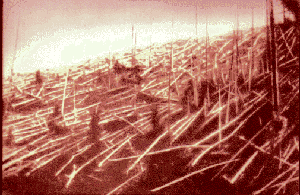Good morning,
The weather forecast for Whitewater calls for a sunny day, with a high of seventy-seven degrees.
On this day in 1908, there was a “A Very Close Encounter of the Second Kind” in Siberia. Although there have been wild theories about what caused the damage on that date and place (alien craft, a tiny black hole) it was surely a meteorite that produced a powerful impact:
The Tunguska event flattened 80 million trees covering 830 square miles of sparsely populated (but not unpopulated) Russian outback in the region of the Tunguska River northwest of Lake Baikal.
Whatever it was — an exploding fragment from a disintegrating meteorite seems the likeliest explanation — scientists concluded there was no actual impact. The explosion appears to have been caused by an air burst similar to that of an artillery round detonating in midair, rather than on impact with the ground. In this case, the fragment, which is believed to have measured perhaps 100 feet across (although new research suggests it may have been even smaller), was probably traveling at around 21,000 miles per hour when it exploded anywhere from 4 to 6 miles above the Earth’s surface.
Based on later assessments of the damage, the force of the blast was estimated to be between 10 and 15 megatons of TNT, roughly a thousand times more powerful than the atomic bomb that destroyed Hiroshima….
Here’s something to consider: In its 1966 edition, The Guinness Book of Records concluded that, based on the Earth’s rotation, had the Tunguska meteorite struck 4 hours, 47 minutes later, it would have obliterated St. Petersburg, then the capital of imperial Russia. Given the events that would shortly torment that nation — and all of Europe — for the better part of the 20th century, one is left to wonder how history might have changed in those circumstances.

There’s more information related to a FW post on Monday about a dog class held at our local campus. See, Wisconsin State Journal: Dogs Sharpen Sniffing Skills at UW-Whitewater. At Walworth County Today, there’s a story entitled, “Class Teaches Dogs Techniques to Help Find Missing People.” The story describes how many challenges the dogs face when trying to track a scent:
Ed Presnall of Walworth, a longtime dog trainer, this week is teaching eight dogs and their handlers how to find elderly people, autistic children and others who might wander away from home.
Presnall is an expert on a technique called variable surface tracking in which dogs follow a scent through an urban environment.
He teaches dogs to navigate over dirt, through grass and across pavement and to overcome distractions.
“The dogs have to work through contamination, not chemical contamination, people contamination—their footprints, their scent, whatever they might leave behind,” he said.
He also teaches handlers to guide their dogs and to respond to their dogs’ natural instincts.
“They have to know their dog. They have to encourage their dog,” he said. “They have to watch for cars and people and other things because the dog is too focused on tracking to watch out for its safety.”
Best wishes and good luck to all the canines and their owners.
